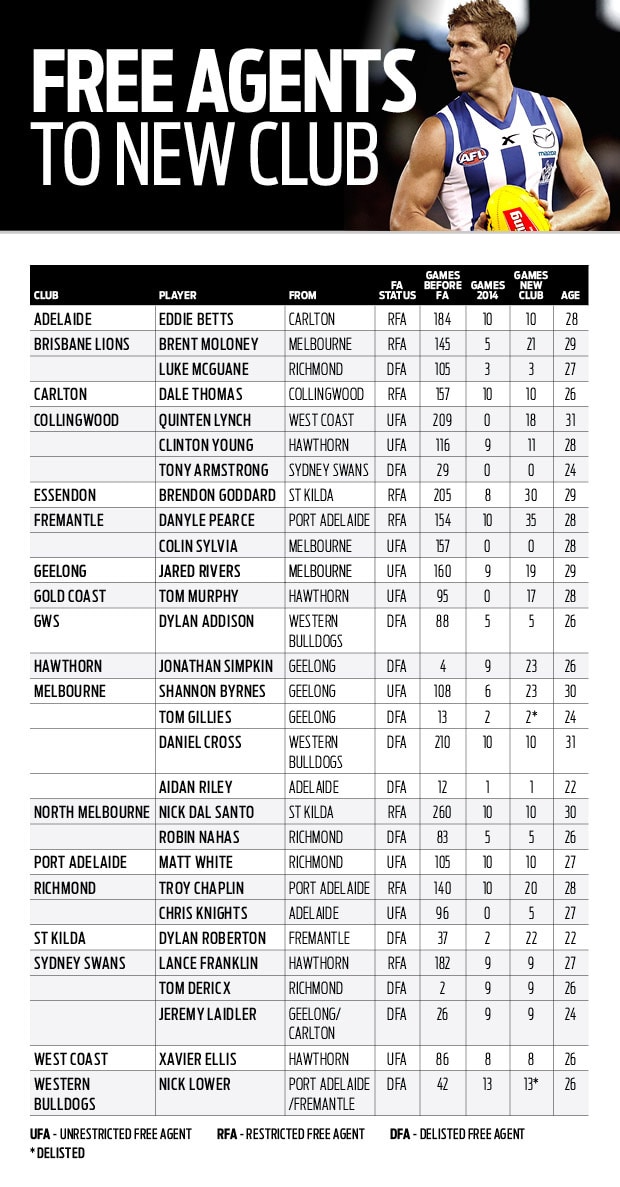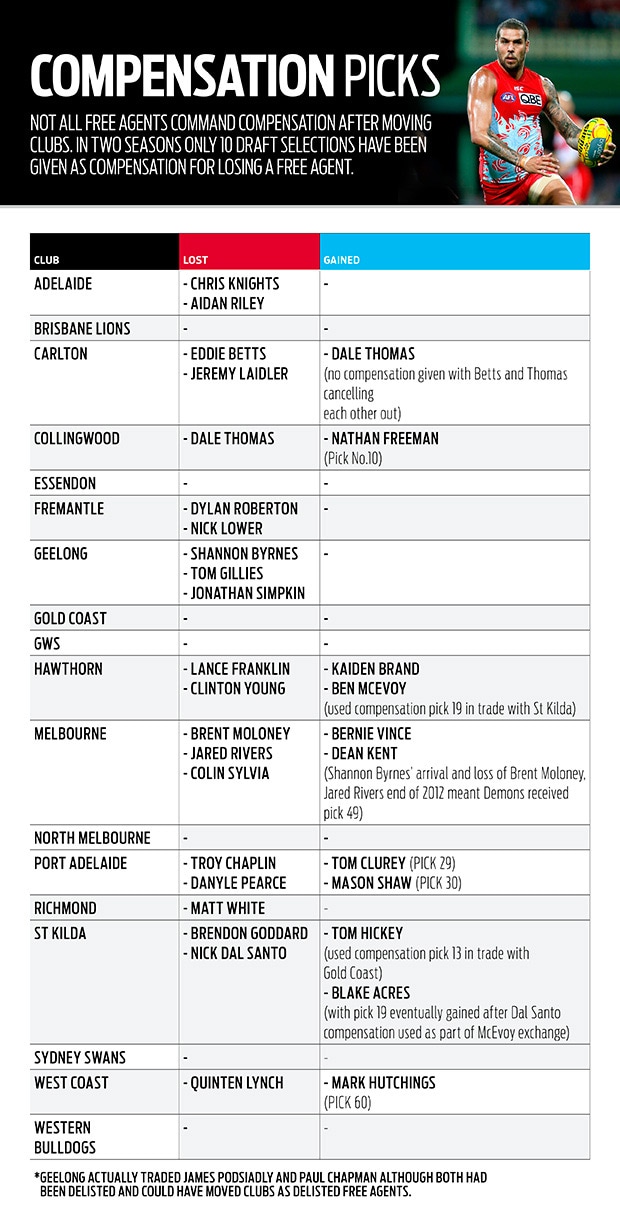And despite the concerns about its effect on competitive balance, it's worth noting that even fewer have crossed from weaker clubs to strong clubs.
Fewer than 20 per cent of free agents at the beginning of 2012 and 2013 have moved clubs.
More than 50 per cent stayed at their club the next season - 57 per cent from 2012, 54 per cent from 2013 - while about a quarter finished up and about two per cent departed after just one more season.
Of the 29 who officially changed clubs through free agency at the end of 2012 and 2013, 56 per cent went to clubs below them on the ladder and 44 per cent to those above them.
Of the more highly prized restricted agents, the story backs the perception of those who believe the system favours clubs in contention.
Seven of the nine restricted agents to move went to clubs above them on the ladder, and the two who didn't, Lance Franklin (Hawthorn to the Sydney Swans) and Eddie Betts (Carlton to Adelaide), hardly moved to battling clubs.
Unrestricted, or more often than not delisted, free agents are those shuffling down the ladder to continue their careers at poorer performing clubs.
One of those players, Daniel Cross, has been a great help to Melbourne on and off the field in 2014. Jonathan Simpkin crossed from Geelong to play in a premiership but the remainder have not yet had a significant impact.
The updated free agency list was released on Monday. Forty-eight players remain on the list, nine fewer than on the original list in March.
The results from the first two seasons suggest that 11 or so will end up changing clubs, and apart from the emotional effect it has on supporters, it is not a huge number in a competition that used 677 players last season.
The complexity of the system of draft compensation for losing free agents makes it difficult to work out whether it is skewed in favour of some clubs, but logic suggests that 'stronger' clubs are more likely to have highly paid high performers who command attention from other clubs.
Getting good compensation might be better than keeping a player in the twilight of his career.
As an example, Collingwood picked up pick No.11 as compensation for losing Dale Thomas (which became pick No.10 and was used to select Nathan Freeman). And Carlton is wrestling with the same issue over Bryce Gibbs.
Even though Hawthorn got under the odds when it received pick No.19 in exchange for Lance Franklin it managed to extract a deal for Ben McEvoy from St Kilda. And as a so-called 'destination club' it will be able to use its extra money well.
The Saints received pick No.13 for Brendon Goddard, which it traded to get Tom Hickey from the Gold Coast, and No.22 for Nick Dal Santo when he joined North Melbourne, which it traded up to select Blake Acres in the 2013 NAB AFL Draft.
Dal Santo is an interesting case study for when free agency might work well.
Few would question the value he has given North in his first 10 games. Averaging 28 disposals (the highest in his career), 12 contested possessions (also a career-high) and with 73 per cent disposal efficiency he is proving to be a good pick-up after 260 games with the Saints.
Add his leadership and what he must be teaching the relatively young midfield and his value goes beyond his individual performance.
Dal Santo also might enjoy North Melbourne so much he sticks around there long after his career finishes. And he has given himself another chance to win a flag.
North Melbourne won his services over more powerful Victorian clubs with smart recruiting, solid presentations and a good environment rather than because it had the biggest house on the street.
The Saints used its compensation on Acres and freed some space in the salary cap to attract other talent.
Acres has played three games so far and has promise, so it will take many years to work out who the move benefited most. By then, if St Kilda has any luck, Dal Santo will be long retired.
One other effect on the market of free agency has been a greater opportunity for in-demand players reaching the age of 27 or 28 to win three-year deals.
As they always have, the best players are still commanding most of the total player payments - the top 10 players received between 40 and 50 per cent of each club's player expenditure last season.
The main beneficiaries of the game's expansion have been talented third- and fourth-year players, who now receive guaranteed money rather than base and match payments and are sometimes commanding wages around the $300,000 a year mark, a figure indicative of their future value.
Free agency means clubs are also trying to sign players earlier, and much trade activity at the end of this season is likely to be centred around prospective 2015 free agents.




